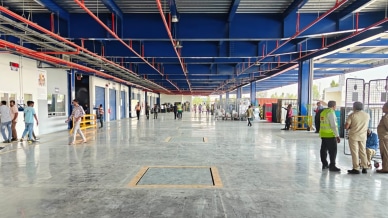Stay updated with the latest - Click here to follow us on Instagram
Bengaluru airport gets country’s largest greenfield domestic cargo terminal, new facility spread over 7 acres
Bengaluru airport currently handles 13 per cent of India’s total cargo and over 40 per cent of South India’s air cargo.

India’s largest greenfield Domestic Cargo Terminal (DCT) in terms of designed capacity was inaugurated at the Kempegowda International Airport in Bengaluru on Thursday. The airport is operated by Bangalore International Airport Limited (BIAL) in collaboration with Menzies Aviation.
The new facility is aimed at enhancing Bengaluru airport’s domestic cargo handling capabilities. It is expected to facilitate improved infrastructure and logistics to accommodate the increasing demands of domestic air cargo.
monthly limit of free stories.
with an Express account.
Facility and capacity
Covering over seven acres, the DCT has a peak handling capacity of approximately 3,60,000 metric tons, with an option to expand to 4,00,000 metric tons. It includes 42 truck docks, over 400 cargo bins, conveyors with integrated X-ray machines, and around 30 unit load device (ULD) build-up and breakdown stations. The terminal is also equipped with 40 handheld terminals and self-service kiosks for agents to improve efficiency.
Technology integration
The terminal features real-time shipment tracking, data analytics tools, and barcode and QR code-based communication systems. These upgrades are intended to enhance data exchange with airline systems, reduce turnaround times, and improve cargo handling efficiency.
Handling of special cargo
Known for handling perishable goods, the Bengaluru airport remains a key export hub for produce like mangoes and coriander. The new terminal expands the airport’s capabilities in managing perishable items as well as other specialised cargo, including valuables, vulnerable goods, live animals, dangerous goods, and radioactive materials.
Sustainability measures
The terminal is designed in compliance with Indian Green Building Council standards, with sustainability-focused features such as sky lighting, advanced ventilation, water conservation systems, and energy-efficient infrastructure. These measures aim to reduce environmental impact while supporting future growth.
Satyaki Raghunath, Chief Operating Officer, BIAL, said, “Prior to this, we had overall capacity of about 7,50,000 metric tonnes. This adds about 3,60,000 to 4,00,000 metric tonnes, taking our overall capacity over 1 million metric tonne.
“Looking at our cargo growth trajectory, we have tripled our handling capacity every decade. When we began operations, we managed around 1,30,000 metric tons of cargo annually. By our 10th anniversary, this had increased to 3,50,000 metric tons… This mirrors our passenger growth, where we scaled from nine million to 27 million passengers in a decade. By the end of this decade, we anticipate handling between 80 to 90 million passengers and close to a million metric tons of cargo annually. Eventually, we will reach a saturation capacity of over 100 million passengers and approximately 1.5 million metric tons of cargo.”
Bengaluru airport currently handles 13 per cent of India’s total cargo and over 40 per cent of South India’s air cargo, the officer added.